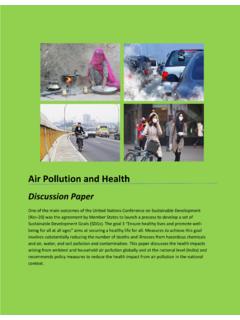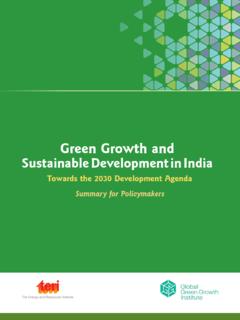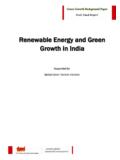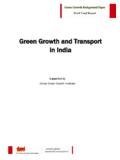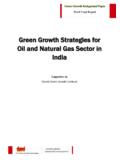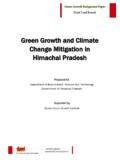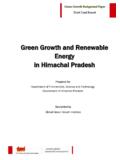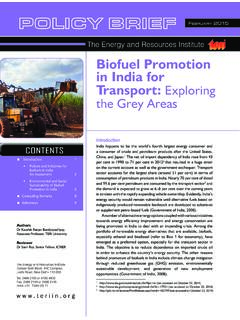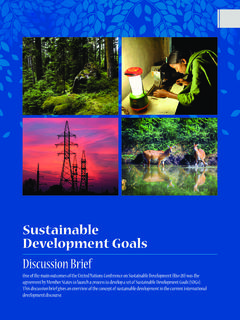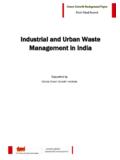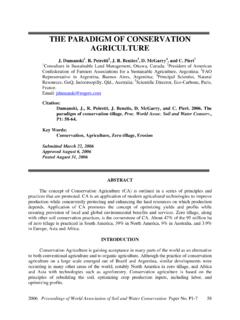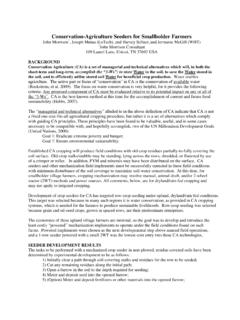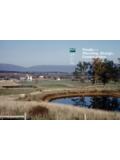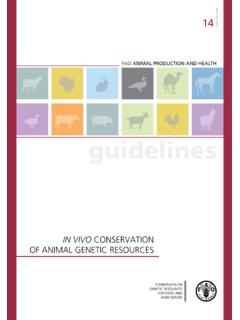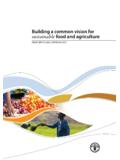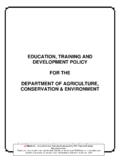Transcription of Green Growth and Agriculture in Himachal Pradesh
1 Supported by Global Green Growth Institute Prepared for Department of Environment, Science and Technology Government of Himachal Pradesh Green Growth and Agriculture in Himachal Pradesh Draft Final Report Green Growth and Agriculture in Himachal Pradesh ii The Energy and Resources Institute 2015 Suggested format for citation T E R I. 2015 Replace this line with the title of the report New Delhi: The Energy and Resources Institute. 28pp. Author Manish Anand, Fellow, TERI Email: Reviewer Prakashkiran S Pawar, Fellow, TERI Email: For more information Project Monitoring Cell T E R I Tel. 2468 2100 or 2468 2111 Darbari Seth Block E-mail IHC Complex, Lodhi Road Fax 2468 2144 or 2468 2145 New Delhi 110 003 Web i i India India +91 Delhi (0)11 Green Growth and Agriculture in Himachal Pradesh iii Table of contents 1.
2 Introduction .. 1 Employment and livelihoods .. 2 Landholdings .. 3 Area, Production and Productivity .. 3 2. Resource use status, issues and challenges in Agriculture in Himachal Pradesh .. 4 Land utilization .. 4 Transitions in farm enterprises .. 6 Mechanization of the farm .. 8 Use of farm 10 Irrigation-water availability .. 11 Measuring progress towards Green Agriculture .. 12 3. Institutional framework .. 13 4. Policy and regulatory interventions .. 19 Schemes of the State Government .. 19 Production of organic manures through vermiculture .. 19 Effective plant protection measures .. 19 Soil and water conservation .. 20 Diversification of Agriculture through Micro-Irrigation and other related Infrastructure .. 20 Promotion of organic farming .. 20 Precision farming and diversification of Agriculture .
3 20 Centrally sponsored schemes .. 21 5. Barriers .. 22 Sustainable land management .. 24 Research and technological interventions for agricultural production .. 24 Indigenous knowledge and traditional Agriculture .. 26 6. Ways forward .. 26 Short-term .. 26 Medium-term .. 26 Long-term .. 27 7. Bibliography .. 28 Green Growth and Agriculture in Himachal Pradesh v List of Tables Table 1 Contribution of different sectors in the primary sector to the gross state domestic product .. 2 Table 2 Changes in occupational structure as percentage of total population in Himachal Pradesh .. 2 Table 3 Distribution of land holding - Himachal Pradesh .. 3 Table 4 Production and area under foodgrains in Himachal Pradesh .. 3 Table 5 Land utilization pattern in Himachal Pradesh (Per cent) .. 4 Table 6 Processwise distribution of the area under land degardation for HP.
4 6 Table 7 Area under principal crops in Himachal Pradesh (in thousand hectares) .. 7 Table 8 Number of farm power sources and implements in Himachal Pradesh .. 8 Table 9 District-wise farm machinery use and gap in Himachal Pradesh .. 9 Table 10 Fertilizer consumption per unit of gross cropped area in Himachal 10 Table 11 Distribution of agrochemicals in Himachal Pradesh .. 11 Table 12 Net irrigated area in Himachal Pradesh through various sources (ha.) .. 12 Table 13 Status of progress towards Green Agriculture in Himachal Pradesh .. 13 Table 14 Proposed actions, type of response and inter-sectoral responsibilities for the Agriculture sector in Himachal Pradesh .. 16 Table 15 Pattern of assistance under Stream II for components relevant to input and resource use efficiency in Agriculture in Himachal Pradesh .
5 21 Table 16 Barriers to Green Growth in Agriculture in .. 23 Table 17 Yield gaps in agricultural crops in Himachal Pradesh .. 25 List of Figures Figure 1 Sectoral contribution to gross state domestic product .. 1 Figure 2 Snapshot of institutional framework in HP Agriculture 14 Green Growth and Agriculture in Himachal Pradesh 1 Green Growth and Agriculture in Himachal Pradesh 1. Introduction Out of the total geographical area of lakh hectares in Himachal Pradesh the gross cropped area is about lakh hectares. With a net area sown of approximately lakh hectares, the cropping intensity stands at About 81% of the total cultivated area in the state is rainfed with a gross irrigated area of lakh hectare and net irrigated area of lakh hectares. Consumption of fertilizers (nitrogen + phosphatic + potassic) per hectare of gross cropped area has increased from kg/ha in 1997-98 to kg/ha in 2012-13.
6 Coverage of area under plant protection measures is likely to reach an all-time high of 5 lakh hectares in 2013-14 from lakh hectares in 2006-07 with an increase in distribution of agrochemicals from 134 MT to 190 MT during the above periods (GoHP, 2014). The share of Agriculture including horticulture and animal husbandry in Gross State Domestic Product (GSDP) had declined from in 1990-91 to in 2012-13. In the 1990s, the sector showed an average annual Growth rate of , which is at par with national level. The economy of the state has shown a shift from Agriculture sector to industries and services as the percentage contribution of Agriculture and allied sectors in total State Domestic Product has declined from in1970-71 to in 1990-91and to in 2013-14 (Figure 1).
7 Agriculture is one of the major contributors to the total domestic product and has overall impact on other sectors via input linkages, employment and trade (Table 1). The Agriculture and Allied Activities sector of the state s economy has recorded a Growth rate of during the Eleventh Five Year Plan and a Growth rate of in this sector has been envisaged during the Twelfth Five Year Plan (GoHP, 2012). Primary sector, which includes Agriculture , forestry, fishing, mining and quarrying, during 2011-12, witnessed a negative Growth rate of The agricultural production has increased from previous year but due to decrease in fruit production this sector registered a negative Growth . Figure 1 Sectoral contribution to gross state domestic product (%) Source: Econ om ic Su rvey of H im ach al Prad esh , Econ om ics & Statistics Dep artm en t, Govern m en t of H im ach al Pr ad esh (variou s years) 1970-711980-811990-912000-012013-14 PrimarySecondaryTertiaryGreen Growth and Agriculture in Himachal Pradesh 2 Table 1 Contribution of different sectors in the primary sector to the gross state domestic product Primary sector 2012-13 (in INR billions) Percentage increase/decrease over 2011-12 Agriculture and Animal Husbandry Forestry and logging Fishing Mining and Quarrying Total Primary Source.
8 GoHP, 2014 Employment and livelihoods There has been a decline in the proportion of total workers engaged in agricultural pursuits from the year 1971 to 1991 indicating movement of workers from the Agriculture sector to the secondary and tertiary sector (see, Table 2). However, thereafter in the decade of 2001, an increase in the proportion of agricultural workers and a slight decline in 2011 over 2001 has been observed. This may be probably due to the fact that higher economic returns from diversification towards high value cash crop might have motivated other farmers to engage in similar activities, and also to the fact that lack of technical skills in the work force might have posed challenge to the farmers to get gainful employment in the industry sector (GoHP, undated).
9 Furthermore, a shift in structure of economy from being an agrarian economy to a diversified economy has not resulted in a corresponding movement of agricultural workers to secondary and tertiary sectors indicating a fall in per worker productivity in the primary sector. As per 2011 Census, of the total population of Himachal Pradesh ( lakh) is classified as main workers, as marginal workers and the rest as non-workers. Compared to the 2001 Census, there has been a decline in percentage of cultivators and increase in agricultural labourers in the 2011 Census. Of the total workers (main+marginal), are cultivators and agricultural labourers in 2011 as compared to cultivators and agricultural labourers in 2001. Table 2 Changes in occupational structure as percentage of total population in Himachal Pradesh Particulars 1971 1981 1991 2001 2011 A.
10 Total workers i) Cultivators and agricultural labour ii) All other occupations B. Non workers Source: Census data (various years) Green Growth and Agriculture in Himachal Pradesh 3 Landholdings The average land holding size for Himachal Pradesh is hectare (Table 3). Distribution of land holdings according to 2005-06 Agricultural Census shows that of the total holdings are of small and marginal farmers. About of holdings are owned by semi medium/medium farmers and only by large farmers. Table 3 Distribution of land holding - Himachal Pradesh Size of holding (ha.) Category (farmers) No. of holdings (lakh) Area (lakh ha.) Av. size of holding (ha.) Below Marginal ( ) ( ) Small ( ) ( ) Semi-medium ( ) ( ) Medium ( ) ( ) More than Large ( ) ( ) Total Source: GoH P, 2014 Area, Production and Productivity During the year 2012-13, the food grains production was achieved at a record level lakh MT against lakh MT during 2010-11.
